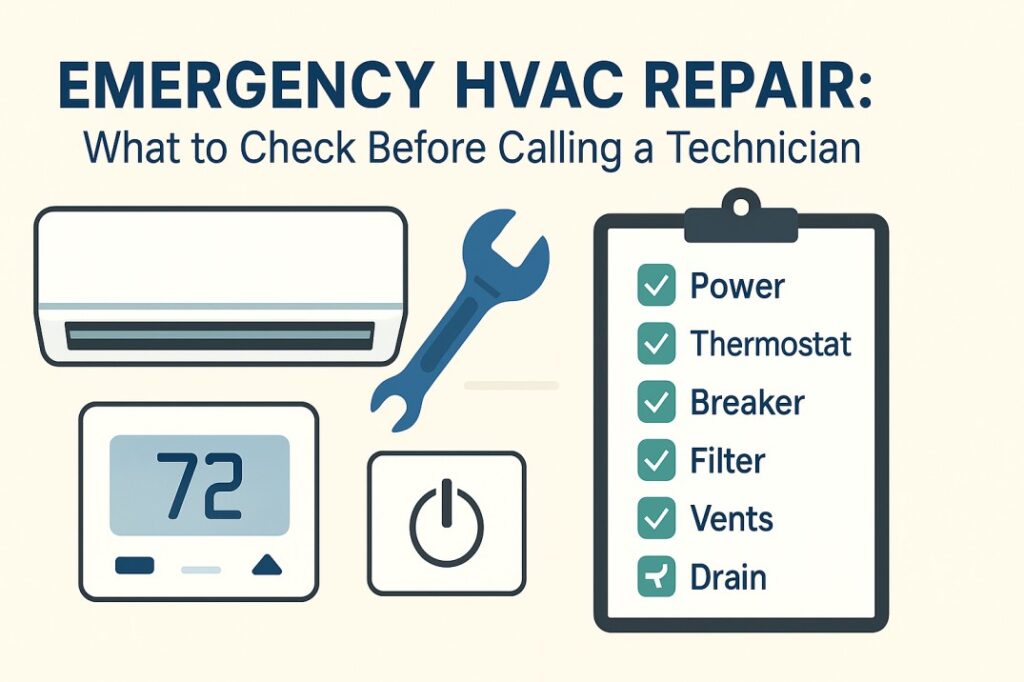It is natural for a homeowner to always be concerned with emergency HVAC repair functionality, especially those highly dependent on it. Regardless, whether it is a broken heat pump, air furnace or or refrigerating unit: knowing when to dial for the big guns is critical to optimization. Knowing when to call for professional help is critical to both spending and upkeep optimization.
Is Emergency HVAC Repair Truly Necessary?
Not all HVAC problems warrant an emergency service. Nevertheless, some issues can be safety hazards or lead to further damage if unattended for a while. Here are cases where emergency HVAC repair is needed the most:
Power is on, but there is no air circulation from the vents.
- The HVAC unit is unresponsive.
- Screeching, banging, or grinding noises
- Burning smells from wires or any electrical components.
- Look for leaks of refrigerants or frost on the coils.
- Indoor temperatures become extremely uncomfortable or dangerous.
In all these scenarios, a certified HVAC technician can be contacted to prevent the problems from persisting.
HVAC System Check: What to Look For First
While setting up a service call, it could also be useful to venture on a DIY HVAC system check methodology in the domain of the HVAC system.
These steps may help you perform an initial self-diagnosis or prepare you to clearly explain the issue to your mechanic.
HVAC Troubleshooting List
Below are several pointers for initial system inspection:
Thermostat settings—Confirm the system is in the cooling or heating mode as required, and the temperature settings are appropriate.
Circuit breaker —check for tripped breakers. A tripped breaker can halt operation of your unit.
Air filter—Confirm the filter is not excessively dirty or has not reached the end of its service life.
Outdoor unit—Inspect for ice, leaves, and any other debris that may obstruct airflow externally.
Vents and registers—Make sure freestanding registers are not obstructed and that furniture is not blocking floor or wall registers.
Following the provided HVAC troubleshooting checklist pointers for your HVAC systems can aid in effective communication with your technician and minimize system downtimes.
Emergency AC Repair: What You Can Do First
The first reaction to an AC outage is usually panic. Before deciding to place an emergency AC repair call, there are some steps you can take that may mitigate the issue.
- Thermostat: Ensure the unit is switched to cooling mode and batteries are replaced as necessary.
- AC coils: Examine the AC coils. If they are frozen, the system should be placed in an off or standby mode to assist with the thawing process.
- Air filter: Inspect for dirt and other obstructive particles that may be in the air filter.
- System: Allow the system to sit unused for several minutes and then reset.
If the problem persists, it might be best to book an air conditioner repair appointment with your HVAC company.
Emergency Heat Pump Repair: Common Signs
Common signs include frequent indicators and occasional brief outages. In regions with continuous air conditioning demands, heat pumps serve dual purposes. This dual-faceted utility means the failure of heat pumps during the harsh winter can not only be an inconvenience but can drastically reduce the comfort level of a household.
The following are conditions to contemplate during an emergency heat pump repair:
- The system operates in heat mode but only produces cold air.
- Secondary heat reserves are often triggered without any actual need to provide heat.
- Ice accumulates on the unit’s exterior.
- Abnormal sound during processes of functioning.
The culmination of the provided symptoms depicts a system trying to function without sufficient resources and is the result of neglectful care.
When to Call for HVAC Emergency Service
Certain challenges in the HVAC system require immediate attention. The following scenarios call for HVAC emergency service:
- A unit-wide failure occurs when the system does not respond to any inputs.
- Production of loud noises, with the addition of strange smells.
- Leaky refrigerants and components that are frozen.
- Inconsistent air circulation services in the different rooms.
- Constant short cycling without any long active durations that counter it.
If after a basic HVAC system check any of the issues outlined above are identified, they should be classified as issues in need of urgent response.
Tips to Prevent Emergency HVAC Repair in the Future
Strategies to Minimize the Chances of a Crossover HVAC Emergency Repair in the Fitness Space Although it can be regarded as impossible to completely negate the possibility of an emergency, in-depth and rigorous scheduled maintenance can be regarded as helpful.
A few simple actions can significantly improve the situation:
- Change your air filters within a window of 1-3 months.
- Arrange seasonal inspections prior to summer or winter.
- Timely cleaning of outdoor units and removal of debris must be done consistently.
- Ignoring strange noises or changes in airflow, no matter how insignificant, can have troubling consequences.
Trust True Temp for Reliable Emergency HVAC Repair
Instant responsiveness is crucial during system breakdowns. True Temp HVAC focuses on emergency AC repair, emergency heat pump repair, and HVAC emergency services, offering responsive repairs and proactive servicing.
Reap the benefits of years of HVAC experience and dependable service. Guiding and servicing your space during heatwaves or chilly mornings is not an issue with the right expert on call.
Schedule an Inspection After Your HVAC System Check
Still autonomous, but who doesn’t benefit from a follow-up inspection? True Temp asserts the importance of thorough inspections, optimizing HVAC system performance while saving the user from surprise failures down the line.
At True Temp HVAC, we pride ourselves on delivering reliable climate control services for year-round efficiency. Whether it’s summer heat or winter chill, our expert technicians ensure your system operates at peak performance with minimal disruptions.
Final Thoughts
Timely tackling of predictive and responsive maintenance is a fail-safe to HVAC emergencies.
Follow a clear checklist for the HVAC troubleshooting system and know what factors to consider, and don’t hesitate to request emergency HVAC repair service when the situation demands it. And remember, you can always rely on True Temp for your comfort needs.

